




Your support is critical to our success.
Acta Mus. Richnov., Sect. Nat. 12(1): 14. 2005
Family: CACTACEAE
= Frailea perbella Prestlé
Succulenta (Netherlands) 59(5): 115. 1980
Accepted Scientific Name: Frailea phaeodisca (Speg.) Backeb. & F.M.Knuth
Kaktus-ABC [Backeb. & Knuth] 250, in obs. 1936 [12 Feb 1936] Backeb., F.M.Knuth

Origin and Habitat: It is found between the cities of Santana do Livramento and Quaraí. Southern Brazil (Rio grande do Sul)
Habitat: The plants grow in pockets of sandy soil on the tops sandstone rocky outcrops or in rock crevices.
Synonyms:
- Frailea perbella Prestlé
- Astrophytum perbellum (Prestlé) Halda & Malina
Frailea phaeodisca (Speg.) Backeb. & F.M.Knuth
Kaktus-ABC [Backeb. & Knuth] 250, in obs. 1936 [12 Feb 1936]
Synonymy: 8
- Frailea phaeodisca (Speg.) Backeb. & F.M.Knuth
- Astrophytum phaeodiscum (Speg.) Halda & Malina
- Echinocactus pygmaeus var. phaeodiscus Speg.
- Frailea pygmaea var. phaeodisca (Speg.) Y.Itô
- Frailea perbella Prestlé
- Astrophytum perbellum (Prestlé) Halda & Malina
- Frailea schlosseri Prestlé
- Frailea schlosseriana H.Schloss.
Description: Frailea perbellaSN|3317]]SN|3673]] is a dwarf cactus with unique and remarkably beautiful shape. It is one of the geographical forms of Frailea phaeodiscaSN|3669]]SN|3669]] and is distinguished for the more elongated stem, darker areoles and whiter spines covering the whole body. It is one of the most attractive species of Frailea, along with Frailea castaneaSN|3673]]SN|3524]] and Frailea buenekeriSN|3669]]SN|3534]]. In habitat one can also find plants with characteristics intermediate with the more common form of Frailea phaeodiscaSN|3534]]SN|3669]].
Habit: It is a small solitary (unless damaged) perennial stem succulent that grows deep seated flat to the ground surface.
Roots: Long, tapered fusiform root, with fine lateral diffuse roots.
Stem: Simple, disk-shaped to globose or somewhat elongate, 1,5-3 tall, 1,5-5,5(-7) cm in diameter pale to dark grey-green or dark brown.
Ribs: 22-26 completely flat or divided into very low tubercles and recognisable only by the straight, dark, vertical line marking each sinus.
Areoles: Elongate with violet-black or brownish black felt (always darker than in the type).
Central spines: Usually absent.
Radial spines: 6-14 small, pectinate, more or less interlaced 1-2,5(-4) mm long, glassy white, (lighter than in the type), completely adpressed.
Flowers: 2,2-3,5 long, 2,2-4 cm in diameter, tepals acuminate, sulphur-yellow or paler. Stigma-lobes 6-7 up to 3,5 mm long.
Fruit: 10 mm across.
Seeds: 1,5-2 mm long 2,1-3 rum broad, shiny, dark brown, smooth, hilum narrowly oblong-ovate.
Remarks: Frailea perbellaSN|3524]]SN|3673]] (syn: Frailea phaeodiscaSN|3669]]SN|3669]]) is a poorly understood taxon that is sometimes regarded as no more than a variety of another dwarf species, Frailea pygmaeaSN|3673]]SN|3317]].
Subspecies, varieties, forms and cultivars of plants belonging to the Frailea phaedisca group
 Frailea perbella Prestlé: has a more elongated body, darker areoles and whiter interlaced spines covering the whole body. Distribution: between the cities of Santana do Livramento and Quaraí. (Rio grande do Sul)
Frailea perbella Prestlé: has a more elongated body, darker areoles and whiter interlaced spines covering the whole body. Distribution: between the cities of Santana do Livramento and Quaraí. (Rio grande do Sul) Frailea phaeodisca (Speg.) Backeb. & F.M.Knuth: has a simple disk like body, elongate brownish black areoles and glassy white, not interlaced spines. Has a long, tapered fusiform root. Distribution: Southern Brazil (Rio grande do Sul) and Uruguay (Tacuarembo)
Frailea phaeodisca (Speg.) Backeb. & F.M.Knuth: has a simple disk like body, elongate brownish black areoles and glassy white, not interlaced spines. Has a long, tapered fusiform root. Distribution: Southern Brazil (Rio grande do Sul) and Uruguay (Tacuarembo) Frailea schlosseri Prestlé: has dark grey-green disk-shaped stems with dark purple “moons” under their areoles. Distribution: North-west Paraguay.
Frailea schlosseri Prestlé: has dark grey-green disk-shaped stems with dark purple “moons” under their areoles. Distribution: North-west Paraguay.
Notes: Seasonal growth and contraction. Frailea perbellaSN|3524]]SN|3673]], like many other diminutive cacti, such as, for instance, Turbinicarpus, Mammillaria, Rebutia, has a well-developed contractile tuberous root system. These tuberose roots have the function of storing enough sustenance so that plants can survive the periods of drought that they have to endure. Tuberous roots also have the function of anchoring the plants into the ground. The tuberose contractile roots continually pull the plants deeper into the ground as the stem elongates so the plants remain subterranean or at an appropriate level in the ground. Contractile roots are usually broad, fleshy, vertical, tapering, and very distinct of the fine absorbent roots and are capable of incredible effort. As commonly happens with tuberous-rooted cacti, in times of drought the plants lose water and shrink, the swollen root contracting and pulling the stem down, resulting in the top of the plant body lying level with, or sometimes even below, ground level. In most cases, contractile roots not only produce a strong pulling force, but also push away the substratum and create a soil channel in which plant movement is made easier. The fleshy contractile roots swell with moisture in the wet season creating a space in the substrate then during the dry season they leave an empty space in the substratum that allow plant movement with minimum or no resistance, at the same time the root dehydrates and shrinks vertically, drawing the plant down into the ground. This is repeated early permitting the top of the plant to remain constantly at the soil level or even completely under the soil level, and frequently the flowers push up through the dirt from the underground cactus body. In fact, even though these plants show a good amount of new growth each year, they hardly get any larger, and their dimensions remain unvaried year after year, as the individual stems tend to contract at the base. The new growth produced during the vegetative season compacts considerably and retracts sometime, pulling the plant down completely under the soil in the hottest months of summer and coldest months of winter. It should be noted that "when specimens are in this withdrawn state, it becomes difficult to find them in their natural state, even though their exact locality is known" This is especially true of the disciform, flat-bodied Frailea species such as Frailea cataphractaSN|3597]]SN|3597]], Frailea phaeodisca and Frailea castaneaSN|3673]]SN|3524]], which can be drawn completely below ground when dehydrated
Bibliography: Major references and further lectures
1) Edward Anderson “The Cactus family” Timber Press, Incorporated, 2001
2) James Cullen, Sabina G. Knees, H. Suzanne Cubey "The European Garden Flora Flowering Plants: A Manual for the Identification of Plants Cultivated in Europe, Both Out-of-Doors and Under Glass" Cambridge University Press, 11/Aug/2011
3) Ashingtonia 1(5): 54 (Illlustration) 1974
4) Succulenta 59(5): 116–119, 185-185 (Illlustration) 1980
5) Keith Grantham, Paul Klaassen “The plantfinder's guide to cacti & other succulents” Timber Press, 18/May/1999
6) David R Hunt; Nigel P Taylor; Graham Charles; International Cactaceae Systematics Group. "The New Cactus Lexicon" dh books, 2006
7) Clive Innes, Charles Glass “Cacti” Portland House, 1991
8) Marlon C Machado. “Fascinating Frailea, Part 1: General impressions.” Cactus World (BCSS) Volume 25 No. 1 March 2007
9) Marlon C Machado.”Fascinating Frailea, Part 2: Review of the species from Rio Grande do Sul.” Cactus World (BCSS) Volume 25 No. 2 June 2007
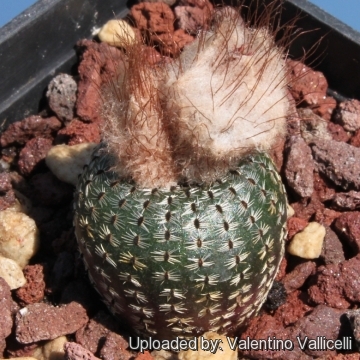
Astrophytum perbellum (Frailea perbella) Photo by: Valentino Vallicelli
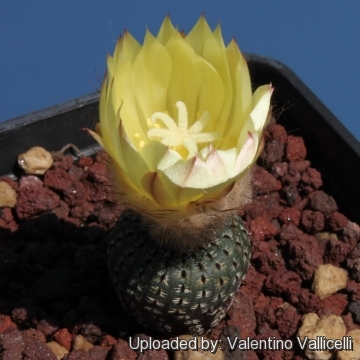
Astrophytum perbellum (Frailea perbella) Photo by: Valentino Vallicelli
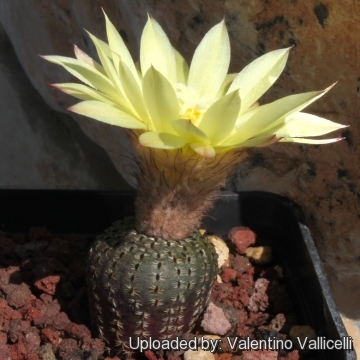
Astrophytum perbellum (Frailea perbella) Photo by: Valentino Vallicelli
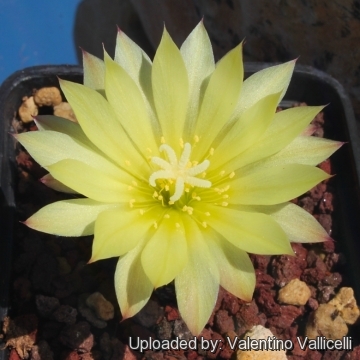
Astrophytum perbellum (Frailea perbella) Photo by: Valentino Vallicelli
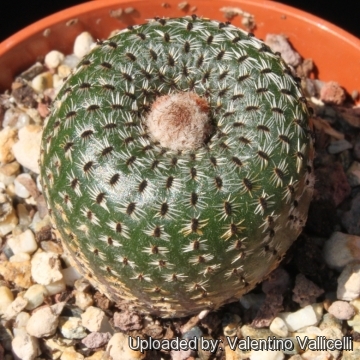
Astrophytum perbellum (Frailea perbella) Photo by: Valentino Vallicelli
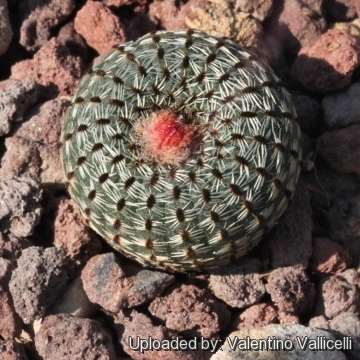
Astrophytum perbellum (Frailea perbella) Photo by: Valentino Vallicelli
Cultivation and Propagation: Frailea perbellaSN|3673]]SN|3673]] is a summer grower species relatively easy to grow. It is sometime seen as a grafted plant but grows very well on its own roots too. Characteristically, during the dry season plants retract completely under the ground both in the wild and in cultivation too.
Growth rate: Fraileas are relatively short-lived plants, only lasting few years (rarely more than 10-15 years in cultivation) and, possible annuals in habitat! In fact they reseed readily around the base of the mother plant from self-set seed if kept reasonably moist during warm weather. It is a
good idea to keep restarting them from seed; what looks like a healthy big plant may suddenly die of old age without warning.
Soil: Use mineral well permeable substratum with little organic matter (peat, humus), plants may become too elongated if compost is too rich.
Repotting: Re-pot every 2 years. Use pot with good drainage.
Fertilization: It grows much faster with a low nitrogen content fertilizer in spring and summer. Potassium helps maintaining the plants compact and healthy.
Watering: Requires careful watering to keep plant compact. Water sparingly from March till October, the thin, fibrous roots suffer if there is humidity, therefore the plant should be watered only when the surrounding terrain is dry. Keep dry as soon as the temperature starts dropping in October and keep it perfectly dry in winter at temperatures from 5 to 15 degrees centigrade.
Hardiness: They need a minimum temperature of 5-10° C (but occasionally temperatures of a few degrees below 0° are not dangerous if kept on the dry side prior to, and during, cold weather). It tends to rot in winter during the resting phase, if kept wet. In the rest period no high atmospheric humidity!!
Sun Exposure: Light shade to full sun, its colour tends to richer and darker when grown in light shade. In a shaded position the plants grow faster, but are not flat shaped and dark coloured.
Uses: It is an excellent plant for container growing. It always looks good and stays small.
Pests & diseases: It may be attractive to a variety of insects, but plants in good condition should be nearly pest-free, particularly if they are grown in a mineral potting-mix, with good exposure and ventilation. Nonetheless, there are several pests to watch for:
- Red spiders: Red spiders may be effectively rubbed up by watering the infested plants from above.
- Mealy bugs: Mealy bugs occasionally develop aerial into the new growth among the wool with disfiguring results, but the worst types develop underground on the roots and are invisible except by their effects.
- Scales: Scales are rarely a problem.
- Rot: Rot is only a minor problem with cacti if the plants are watered and “aired” correctly. If they are not, fungicides won't help all that much. To prevent rottenness it is also advisable to surround its root neck by very rough sand or grit, this help a fast water drainage.
Propagation: With fresh harvested seeds or (rarely) by grafting. Fraileas set seed (when well grown) and grow easily from seed. In fact, they are reported to set seed even if the flower doesn’t open. This self-fertilization is called cleistogamy. Seedlings dislike strong light and dry conditions and need to be repotted frequently during the first few years. However, old plants become senile and have a tendency to succumb to disease and a weak root system. At this stage, as is well known, they die suddenly. So, after they reach about 4-5 cm in diameter grow them slowly, and adopt a new repotting period, using intervals of every 3-4 years. Additionally grow them under drier conditions or with stronger sunlight. But plants are sometine grafted to accelerate growth, but the grafted plants are typical rather tall growing, compared with plants on their own roots that are usually more flat to the ground.
| Your Actions | |
|---|---|
| Back to Astrophytum index | |
| Back to Cactaceae index | |
 |
Back to Cacti Encyclopedia index |
Privacy stantement - Terms and conditions - How to cite - About us - Feedback - Donate



